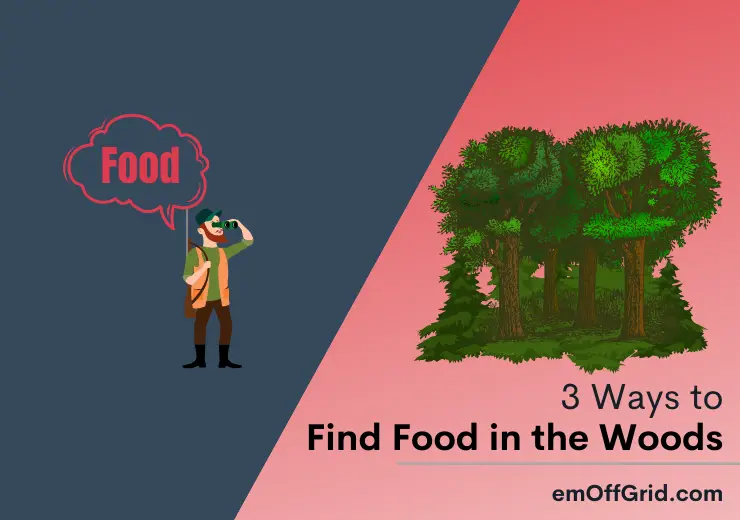Do you want to know 3 ways to find food in the woods? It is not as challenging as you may think. You can forage for edible plants or hunt small and big game animals. Also, you can head to the waters if you know how to fish.
You can find yourself lost in the woods without any food backup source. That is when you will realize how crucial your survival skills are. It pays to have survival skills and know the food types to look for in the wilderness.
Read on for details on how to find food in the woods. We have also included a list of edible plants and animals to consider for survival.
Contents
How to Find Food in the Woods
Survival instinct kicks in first when you live in the woods or adopt an off-grid lifestyle. Fortunately, you don’t need processed foods or stockpile anything to start your new life. You can become a gatherer or a hunter, just like native Americans.
You can find food in the woods in the following ways:
Option 1: Become Gatherer
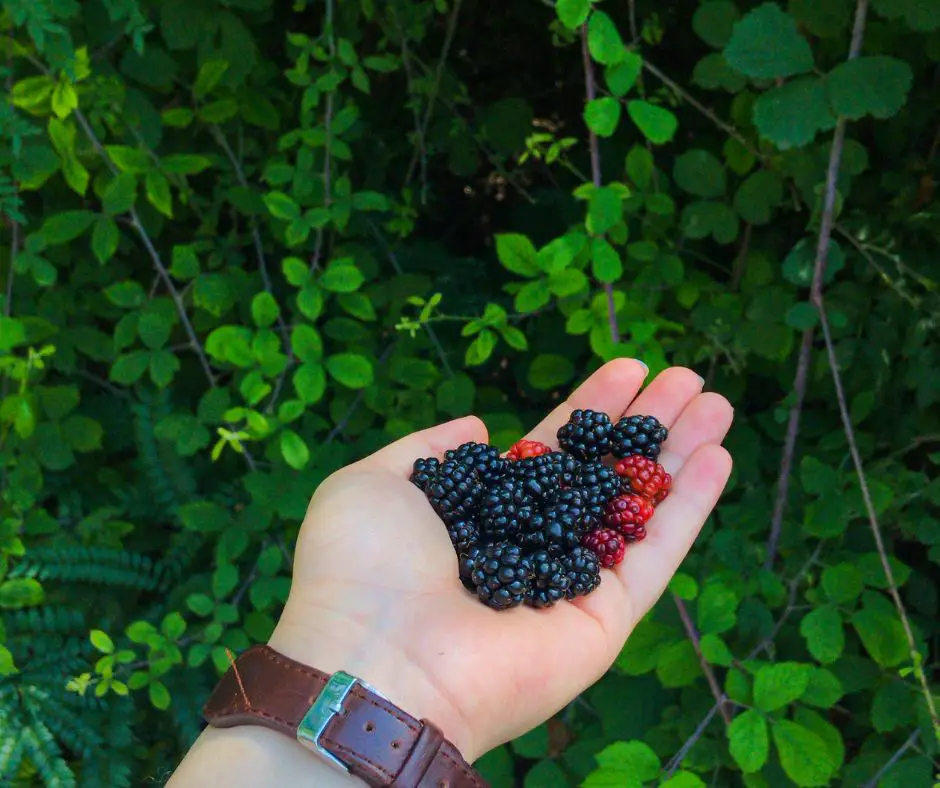
You can survive solely on a plant-based diet, just like vegans. Besides, plant foods are readily available in the woods. All you need are foraging skills to gather enough food for you and your family.
So, becoming a gatherer is the first choice. You don’t need extra tools, and plants are a complete meal for human survival.
Focus on Flora
Becoming a gatherer means switching your focus to plants. You can forage for fruits, vines, tubers, nuts, stems, and leaves, provided they are edible. Wild berries are a few examples of what nature can offer you for free.
Excellent foragers use their sense of smell to lead them to where there are ripe fruits such as wild apples, berries, and other fragrant edible plant parts.
You can come across dandelion, asparagus, garlic mustard, elderberry, wild raspberry, curled dock, and many more. These are all perfect examples of edible wild plants.
Tips For Edibility Test
Mother nature offers you everything in the woods. However, you cannot eat any fruit or plant parts you come across. Some are poisonous and can be fatal if immediate medical assistance is not provided. So, how do you know which plants are edible and which ones are poisonous?
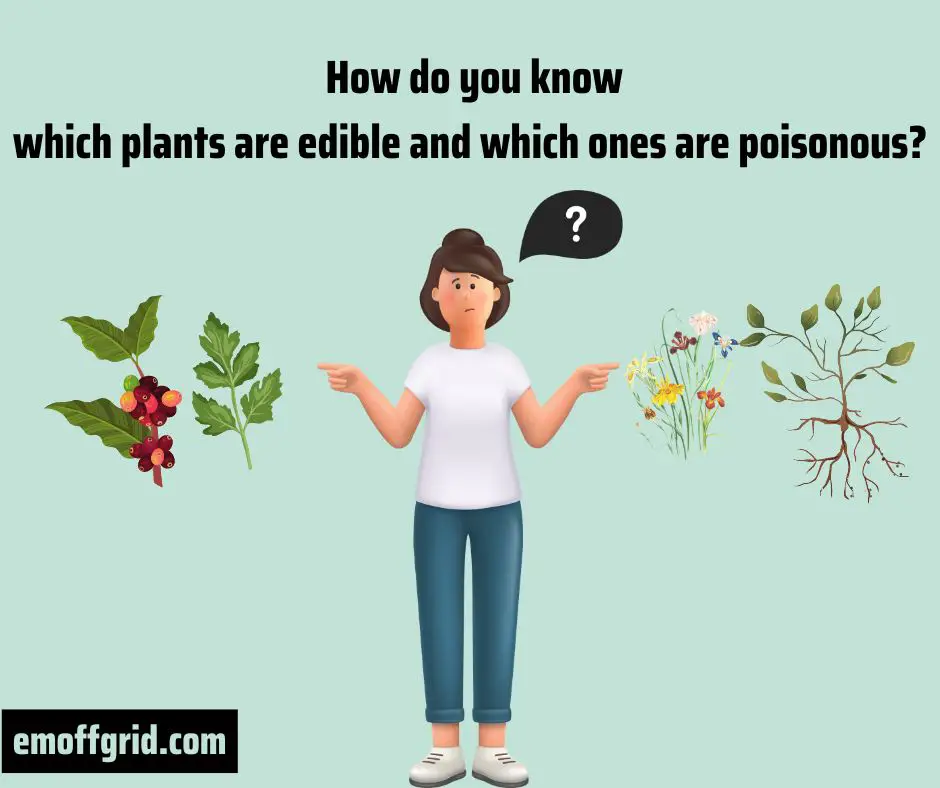
Conducting an edibility test is the only way to know safe plants for human consumption. Use the following tips to tell the difference between edible and inedible plants in the wild:
- Do an edibility test on an empty stomach, and do not eat anything. Just drink a lot of water and eat nothing for 8 hours before conducting the test.
- Gather enough of the plant parts to test since the universal eligibility test takes a lot of time. You don’t want to deplete your stock before getting a conclusive result.
- Avoid plants that smell like almonds or have natural indicators of toxicity. Stay away from berries or plant parts with burned or raw almond fragrance.
- Don’t eat plants that look like parsley, dill, or parsnip greens. These are likely poisonous and should be avoided.
- Don’t eat plants with bitter, soapy, or any other strange taste. It is a way nature warns you not to eat that plant because it is potentially poisonous.
- Separate the plant parts and test them separately. The leaves of a plant may not be edible just because its fruits are sweet and edible.
- Do not test plants such as mushrooms with milky sap, spines, fine hairs, waxy leaves, and umbrella-shaped flowers. Also, green and white berries should not feature in your list of edible plants.
Option 2: Become Master Hunter & Trapper by Small Games
You can also hunt small game animals to supplement your diet. Game animals are a rich source of food in the woods. However, you should not rely solely on a meat diet as you will be lacking vital vitamins the body needs.
Game animals are a source of protein and fat, which suits your diet if you are not a vegetarian.

7 Tools For Small Game
Unlike foraging, you need special tools to hunt small game animals. The most common tools for hunting small game animals include the following:
Stone Ax Head
The stone ax head is an essential tool if you want to make a kill. You can use it to kill the animal and cut it into sizable pieces. You can make this ancient tool yourself by looking for an appropriate rock or stone that can split into sharp edges.
Making a stone ax head is a DIY process you can do right in the woods.
Spears
Spears are excellent for making a kill at a distance. Small game animals do not give you the time to ambush them. So, it is best to give your shot from a distance.
You can also improvise the spearhead from stones. But if preparing for survival, buying a few iron spearheads can do the trick.
Bow and Arrow
Bows and arrows are an ideal choice for expert hunters who also have arrow-throwing skills. You can use it to kill small game animals many yards away if you can hit the bull’s eye.
DIY arrows exist, but you can buy commercial ones. The latter option even comes with binoculars to help you aim at the target better. They are also better engineered for hunting and self-defense if need be.
Bear Archery Cruzer G2 Adult Compound Bow
- VERSATILE: Maximum-versatility bow is engineered for all ages and skill levels
- READY TO HUNT: Ready to hunt bow comes equipped with six Trophy Ridge accessories
- ADJUSTABLE: Adjustable from 12" to 30" draw length range and from 5 to 70 lbs. peak draw weight
Get Good at Fishing
Fishing is also an option when you need to find food in the woods. However, it only applies if you have a river, lake, dam, or ocean nearby where fishing is permitted. You need a fishing rod and hook and bait.
Alternatively, you can cast your overnight and collect your catch the following morning. But before doing that, consult your local laws regarding fishing in your region and ensure you use the right size of fishing net.
Zebco 404 Spincast Reel and 2-Piece Fishing Rod Combo
- EASY-TO-USE: The Zebco 404 spincast reel and rod combo has been a mainstay with anglers for years. The combo features a 5-foot 6-inch 2-piece fishing pole, size 40 reel and a 28-piece tackle kit. Its moderate-fast action and medium power is ideal for targeting medium and heavy species from walleye to bass, walleye, catfish, striper and more. Designed to hold a 10-17-pound line weight and 1/4-5/8 oz lure weights
- BUILT-IN BITE ALERT: You will be amazed by the built-in bite alert designed to alert anglers of activity below the water. Bite alert is a mechanical system that disengages the anti-reverse of the reel and engages a clicker to create a sound when line is being taken out so you will not be mistaken when your next trophy is on the line
- TOUGH YET SLEEK: Utilize the convenient dial-adjustable drag and the QuickSet anti-reverse features to stop your handle from moving backward and create a solid hookset in the mouth of a fish when reeling in your prize catch. This reel boasts premium all-metal gears and a 2.8:1 gear ratio. This right-hand retrieve reel comes pre-spooled with 15-pound Zebco fishing line so you can start your fishing adventure sooner
Ground Snares
Snares are long pieces of wires with a loop at one end. The other end is attached to large, stationary objects such as trees. Snares are used for hunting small game animals by setting them up along the game trains or water homes.
Snares catch game animals on the neck as they try to pass by. Though this hunting method is effective, it is non-selective. You never know what to expect when approaching your trap a few hours later.
Deadfall Traps
Deadfall traps are simple and easy to set up to catch small game animals. It consists of a heavy board or a log that falls on the target when triggered, often killing the animal.
The only challenge in using deadfall traps is the skills required to create the triggering system. Also, you cannot target a specific animal.
Spring Traps
Spring traps are foot-hold restraining devices laid on the ground to catch and hold small game animals. This game trapping method is more than a century old and is widely used for its cost-effectiveness and efficiency.
Different designs of spring traps exist. These target animals of varying sizes, including smaller ones such as weasels and squirrels.
Animals Suitable For Small Game
We have talked about hunting small game animals in the woods for food, but what exactly are they?
Small game is a term describing any wild animals that weigh less than 40 pounds. However, different states and countries have different definitions of the same. Consult your local laws to find out what qualifies as a small game.
Small game includes the following:
- Squirrels
- Hares
- Rabbits
- Jackrabbits
- Prairie Dogs
- Quail
- Grouse
- Pheasant
- Snowshoe hare
- Woodchucks
- Marmots
Option 3: Learn How to Make a Weapon and Know How to Hunt Animals
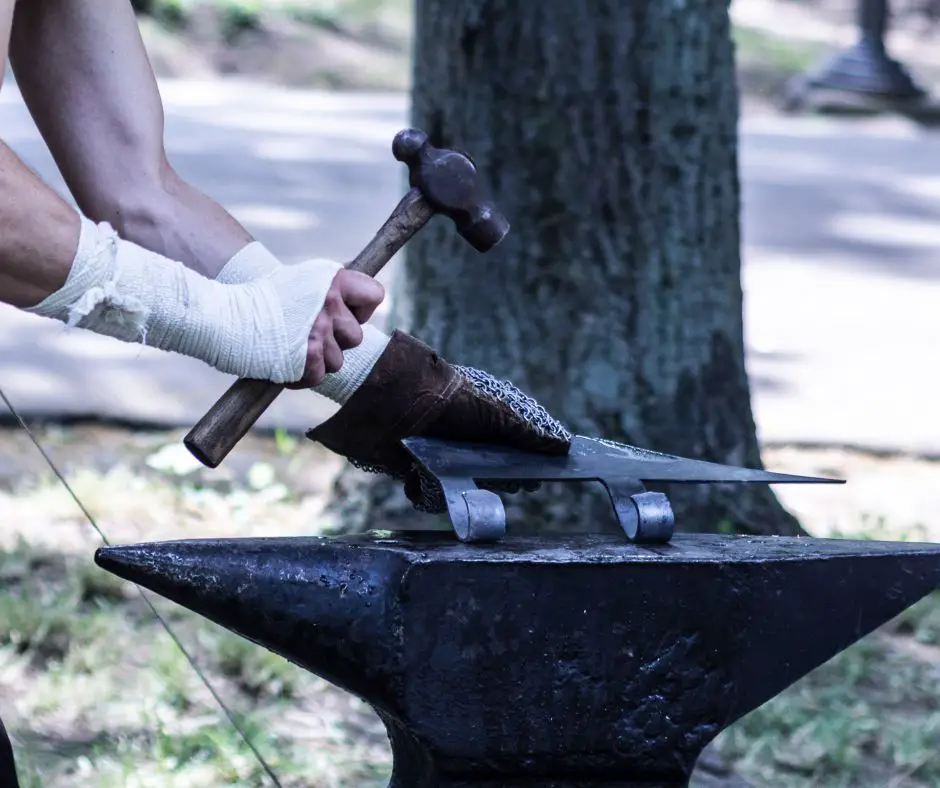
Life in the woods is different from that in developed areas. It is about the survival of the fittest, and the best way to survive is making your own weapons and learning how to hunt.
Hunting big game animals is under heavy regulation by state laws. Hunting them is limited or prohibited in different places.
So, it can never be a reliable food source in the woods. But if you can hunt even one down, you are in for a prize. Meat, bones, tusks, body fat, fur, and hide are all valued.
What animals qualify as a big game? These are animals with subsistence or sport-hunting qualities. They also differ from state to state, but the most common ones include the following:
- Deer
- Elk
- Moose
- Antelope
- Caribou
- Mountain sheep
- Mountain goat
- Bighorn sheep
The most common weapon for hunting game animals is the firearm, specifically a long-barreled rifle. You can also use shotguns, handguns, muzzleloaders, or variations. Also, the most recommended ammunition is the large-caliber.
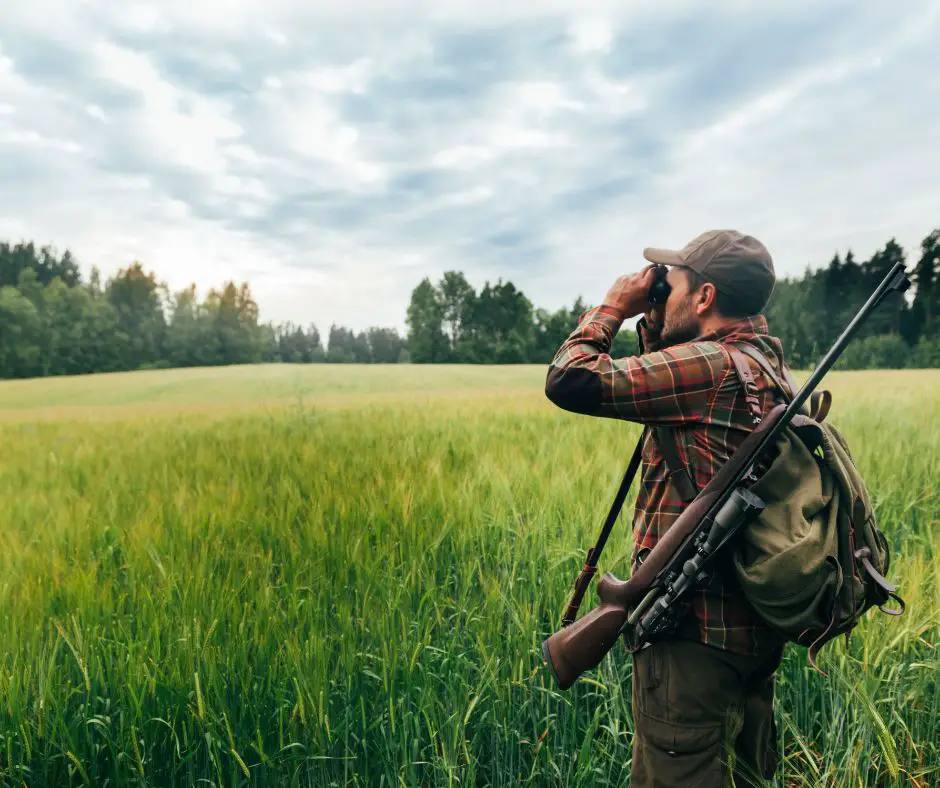
Hunting large game animals requires skills in using a rifle or firearm you have. It also requires the best hunting ethics, including making a clean and humane kill.
146 Wilderness Foods In the Woods
Mother nature is generous. It can provide up to 146 foods in the wood for humans. Your only role is to find and eat them, cooked or raw. The following is the detailed list:
Meat From Animals
Game meat is a rich source of proteins for bodybuilding. They are used in making new cells and tissue to replace dead or worn-out ones. Additionally, protein allows metabolic reactions and aids the coordination of other bodily functions.
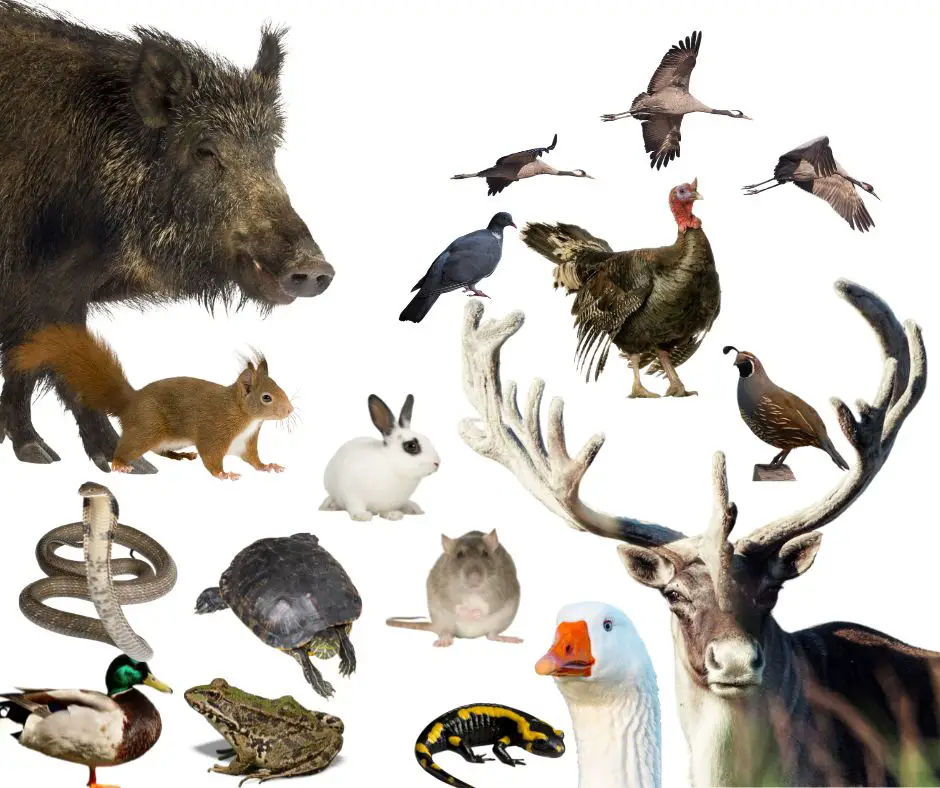
Fortunately, catching game animals in the woods is easy if you have hunting skills and if the state laws permit it. Consider the following options:
- Wild boar
- Wild turkey
- Caribou
- Chipmunk
- Cranes
- Ducks
- Elk
- Frogs
- Geese
- Grouse
- Hares & rabbits
- Herons
- Mice
- Moose
- Pigeons
- Quail
- Salamanders
- Snakes
- Squirrel
- Swans
- Turtles
- Whitetail deer
Insects
Insects can be challenging to find because some of them are seasonal. Others may be too small to gather or hide in the burrow or other hard-to-find places. If you are lucky, you can find the following insects in the woods to supplement your diet:

- Ant larvae
- Ants
- Aphids
- Beetle
- Beetle larvae
- Crickets
- Earwigs
- Grasshoppers
- Sowbugs
- Termites
Ocean Life
The ocean is fluorescing with flora and fauna, some of which are edible. Finding them can be a bit challenging, especially if you don’t have the skills. Also, an ocean may be far from other places, making sourcing food practically impossible.
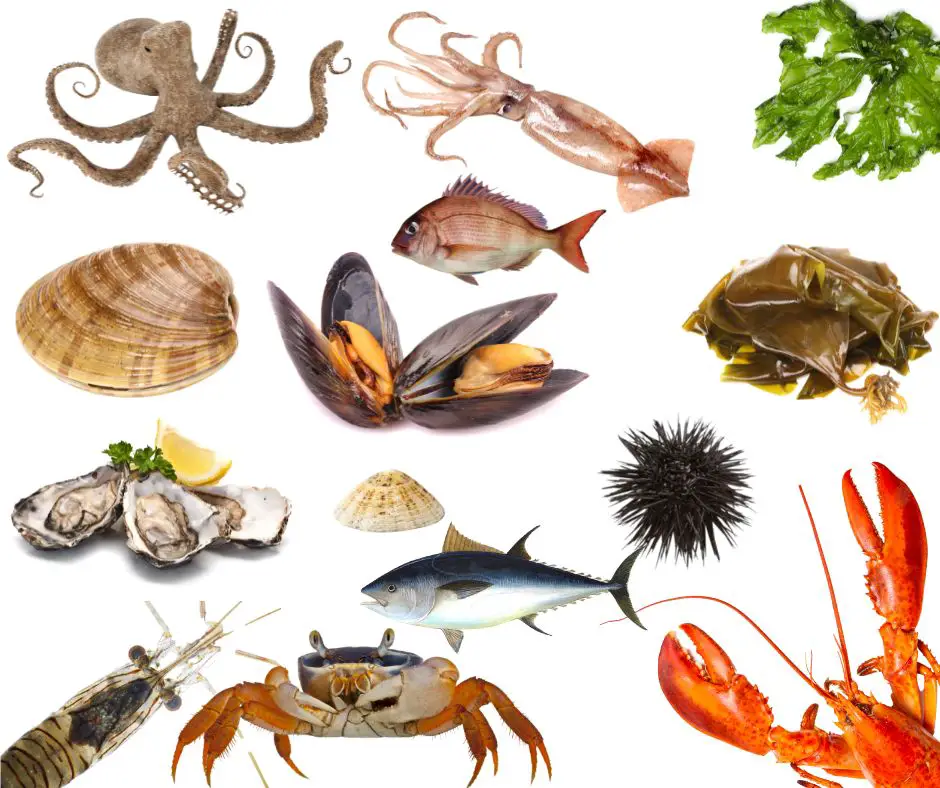
Some edible plants and animals from the oceans include the following:
- Fish
- Octopus
- Shrimp
- Clams
- Mussels
- Limpets
- Periwinkles
- Squid
- Urchin
- Oysters
- Lobster
- Crabs
- Sea lettuce
- Kelp
- Nori
- Dulse
Fruit And Berries
Fruits and berries are excellent sources of vitamins and other nutrients the body needs to defend itself from foreign invaders and other functions. These are readily available in the woods and are edible right from the tree. Consider the following fruits and berries:
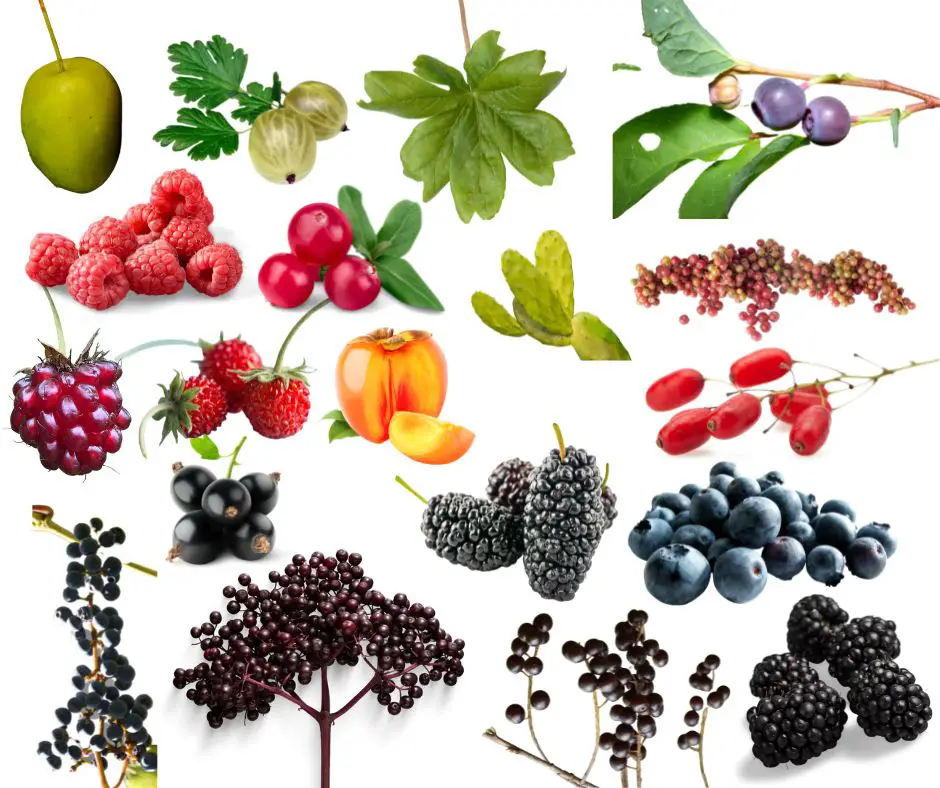
- Wild apple
- Wild grape
- Wild strawberry
- Wild black cherry
- Bunchberry
- Mulberry
- Currant & Gooseberries
- Persimmon
- Hawthorn apples
- Cactus
- Agave
- Huckleberries
- Blueberries
- Cranberries
- Elderberry
- Gooseberry
- Salmonberries
- Blackberry
- Autumn Olive
- Barberry
- Raspberry
- Mayapple fruits
Flowers, Wild Greens, Tubers, Roots, Shoots
Flowers, tubers, shoots, roots, and wild greens are excellent food choices. Many people forage for them in the wild to supplement their backyard vegetables. Check out the items on this list:
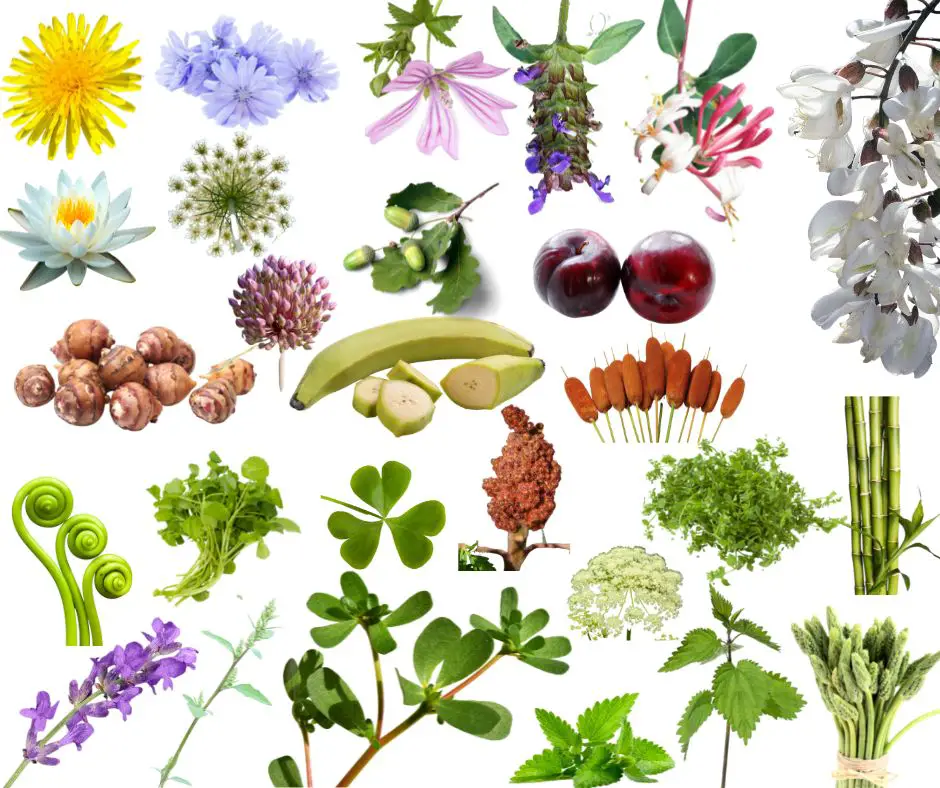
- Day lily
- Wild rose
- Trout lily
- Black locust
- Violets
- Dandelions
- Mints
- Honeysuckle
- Passionflower
- Chicory
- Wild asparagus
- Nettles
- Plantain
- Lambs quarters
- Purslane
- Self-heal
- Mallow
- Miner’s lettuce
- Fiddleheads
- Water lily roots
- Burdock root
- Thistle root
- Taro root
- Bamboo shoots
- Jerusalem artichoke
- Cattail roots and shoots
- Watercress shoots
- Larch and Hemlock shoots/tips
- Wild carrot
- Wild onion
- Wild garlic/ Wild Leeks
- Onion grass
- Wood sorrels
- Indian cucumber
- Wild lettuce
- Japanese knotweed
- Stinging Nettle
- Common Milkweed
- Staghorn Sumac
- Shagbark Hickory Nuts
- Beach Plums
- Catnip
- Chickweed
- Lamb’s Quarters
- White Oak Acorns
Nuts, Grasses, Grains, Seeds, and Pods
An ideal survivor cannot leave nuts, grasses, grains, seeds, and pods out of the list of possible foods in the woods. Some may be hard to find, especially nuts, but a little effort can see you fill your basket in no time. Consider the following:
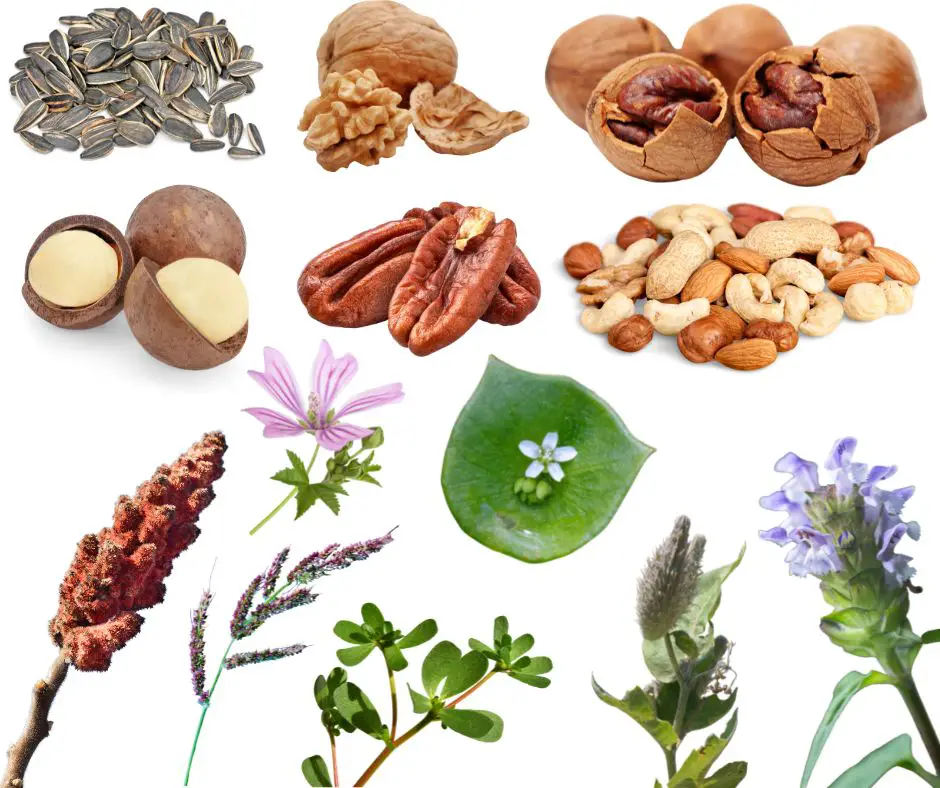
- Sunflower seeds
- Walnut
- Wild barnyard grass
- Wild rice
- Wild rye
- Larch and Hemlock shoots/tips
- Macadamia
- Mallow
- Mesquite pods
- Milkweed pods
- Miner’s lettuce
- Passionflower
- Pecan
- Pinon nuts
- Plantain
- Purslane
- Self-heal
- Shagbark Hickory Nuts
- Staghorn Sumac
What You Can Not or Should Not Eat in the Woods
You cannot eat everything you come across in the woods. As mentioned, some are potentially poisonous and can be fatal to humans. It is better to stay away from any plants with toxic traits.
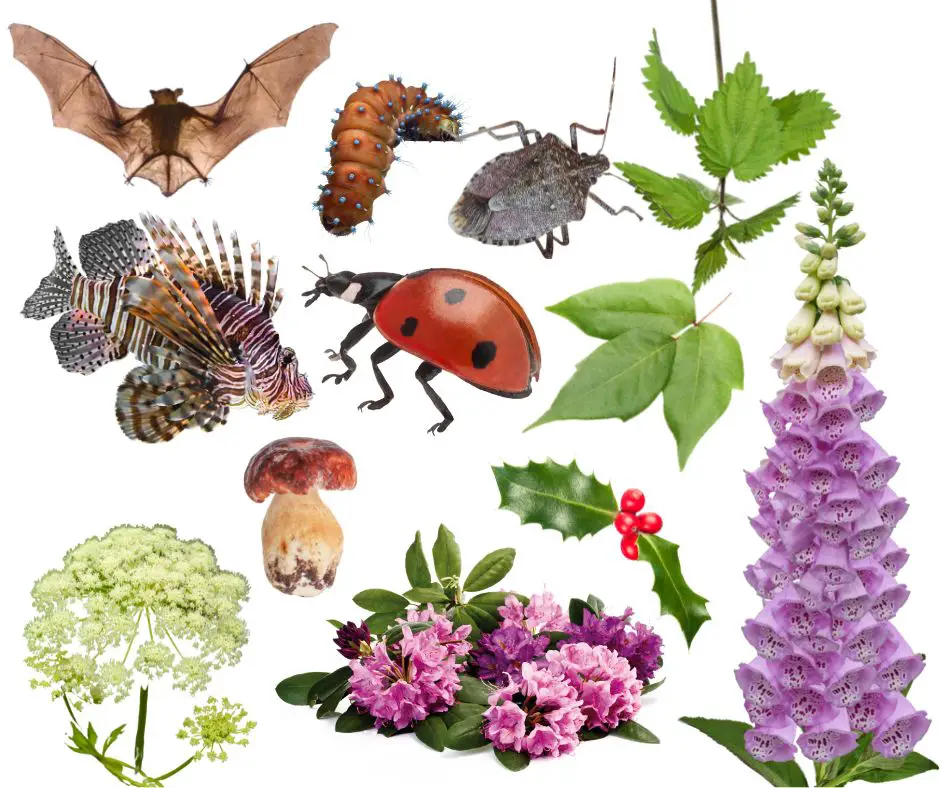
If you are foraging in the wild, do not eat any of the following:
- Hemlock
- Foxglove
- Bats
- Holly
- Lionfish
- Rhododendron
- Horse nettle
- Poison ivy
- Mushrooms (unless you are sure it is edible)
- Lichen
- White and green berries
- Some insects (brightly colored ones, have fuzzy hair, sting)
How to Get Fresh Water In The Woods

When you’re in the woods, it’s important to know how to find food and water. While there are many sources of food in the woods, fresh water can be more difficult to come by. Here are a few tips on how to get fresh water in the woods:
1. Look for rivers, streams, and lakes. These are all great sources of fresh water. These are generally the safest sources of water, as they are less likely to be contaminated than stagnant water sources.
2. If you can’t find any bodies of water, look for areas where the ground is damp or has vegetation growing on it. These are likely areas where there is a underground water source.
To purify your water, you can boil it for at least five minutes, or use a water purification filter.
3. Dig a small hole in the ground and wait for it to fill up with water. This method is called “digging a still” and can be effective if you can’t find any other sources of water.
4. Collect rainwater in a container. This is an easy way to get fresh water, but you’ll have to wait for it to rain!
5. Finally, if you’re desperate, you can drink your own urine. It’s not the most pleasant option, but it will provide you with some hydration.
Tips to Keep You Safe in the Woods
Wood can be potentially dangerous. You can be a victim if you are not careful, but the following tips should keep you safe:
- Be sure to drink plenty of fluids and stay hydrated, even if the water doesn’t taste great. In the woods, being able to find and purify freshwater is an essential survival skill.
- Do not eat any plant or animal you are not sure if edible or not
- Eat what you know and know what you eat
- Eat only safe insects and avoid bugs such as spiders and millipedes.
- Avoid eating hairy or stinging insects such as bees
- Avoid brightly-colored insects and mushrooms like a plague
- Read or carry a guide book e.g.
How to Eat in the Woods
- Hardcover Book
- Angier, Bradford (Author)
- English (Publication Language)
Last Sentences
Survival skills come in handy when you are stranded in the woods. You can intentionally choose to live there or find yourself lost in the woods. That is when the foraging and hunting skills are put to the test.
Luckily, mother nature has a wide range of fruits and plants you can feed on for survival. You can eat fruits, berries, nuts, tubers, shoots, flowers, and meat from hunted game animals.
Thank you for your time reading this article at Em Offgrid. We appreciate your time and kindly ask you to share it with friends if it is informational. Help us reach more people and enlighten everyone!
